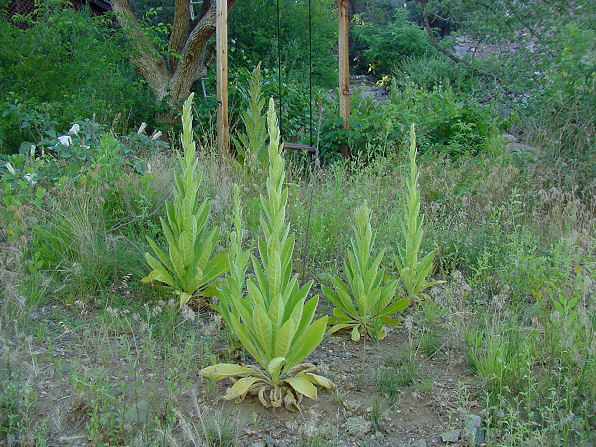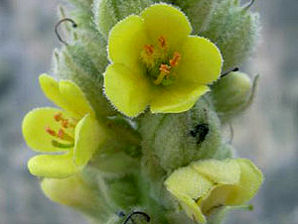Arizona Wild Flowers
Pictures, Photos, Images
Descriptions, Information, Reviews.
Common Mullein, Verbascum thapsus.
We Are Proud Of Our SafeSurf Rating!
Click On Any Of The Following Links By Amazon.Com
For Books, & Videos About Wildflowers Of Arizona & The Southwest USA. No Obligation!
 |
| Common Mullein, Verbascum thapsus; June 18, 2005. Lynx Creek. |
|---|
 | |
| Common Mullein, Verbascum thapsus. | Common Mullein, Verbascum thapsus. |
|---|---|
 |  |
| Common Mullein, Verbascum thapsus. | Lambs Ears Flowers. |
Common Mullein.
We wish to thank Wikipedia, the free encyclopedia for some of the information on this page. We share images and information with Wikipedia. A common biennial herb, which produces a basal rosette of large, stalked, thick, fuzzy, oval leaves that range from 4-12 inches in length and 1-5 inches in width in the first year. These leaves often survive through the winter. In the second year, mullein sends up an erect, flower stalk, up to about six feet tall, which is fuzzy, and has smaller, oval, alternate leaves. Medicinally, it is expectorant, anti-inflammatory, antibiotic, astringent, and demulcent. It is especially soothing (and is a good tonic for) the lungs, mucous membranes, and glands. We do not recommend trying this plant as a medicine. If you soak the flower heads in tallow it makes a good torch. The leaves, dried and rolled, have been used as lamp wicks. Native Americans lined footware with its leaves for warmth.
Quick Notes:
Height: Biennial herb growing to about 6 feet tall.
Flowers: The flowers are yellow with 5 unequal lobes, 5 orange tipped stamens up to 1 inch wide, in tightly wedged spikelike clusters.
Flower Stalk: The flower stalk is about 18" - 60" long, smooth, and dark green.
Flowering Time: June - September.
Leaves: The leaves are gray - green, oblong, thick, hairy, basal leaves in a rosette up to about 16 inches long.
Found: Native of Europe. It may have come from the Mediteranian or Britain.
Hardiness:
Soil pH requirements:
Sun Exposure:
Elevation: 4,000 - 7,000 Feet.
Habitat: Disturbed areas, roadsides, rocky stream banks and open areas.
Miscellaneous: Flowering Photos Taken June 18, 2005. Lynx Creek, Arizona. There are three species of Verbascum in Arizona.
|
We Are Proud Of Our SafeSurf Rating!
Click On Any Of The Following Links By Amazon.Com
For Books, & Videos About Wildlife Of Arizona & The Southwest USA. No Obligation!
| © 1966 - Present, Audrey, Eve, & George DeLange |